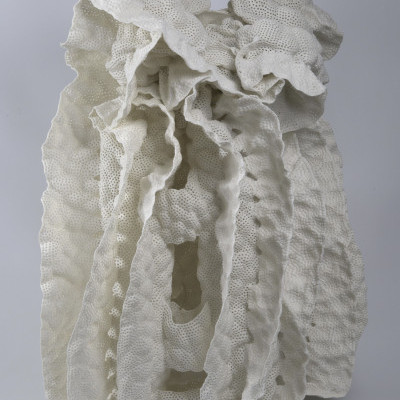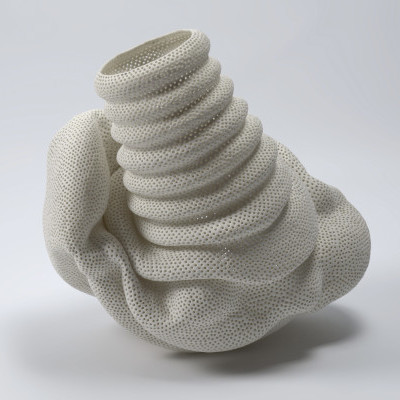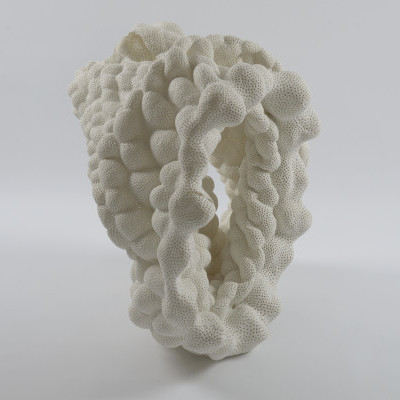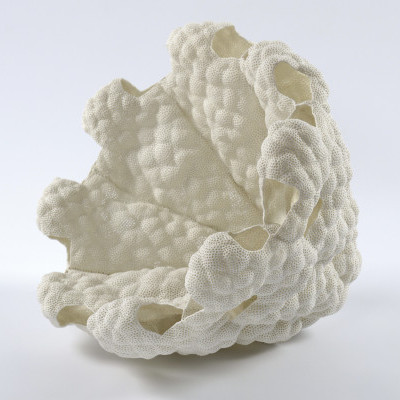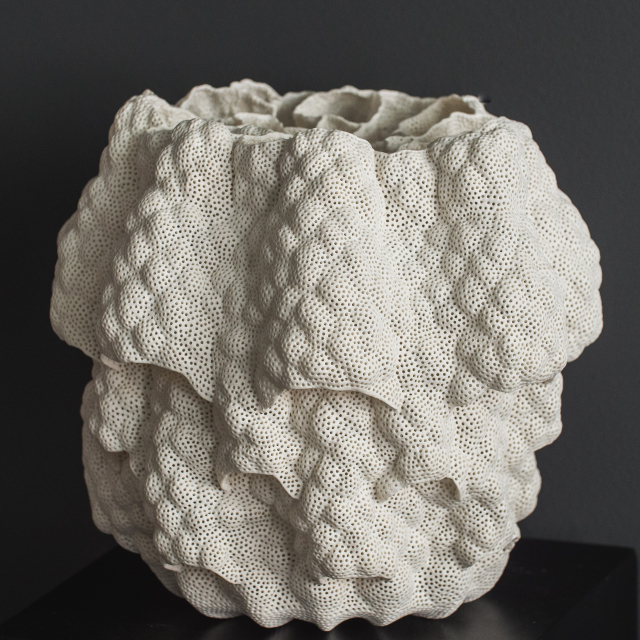H. Füzesi
Keramikus művész / Ceramic artist
Biography
" According to the Vedas, India's oldest literary relics, the universe is vibration. The vibrating field encapsulates all information: it can be compared to a dewy spider's web that spreads infinitely in all directions of space. A web of dewdrops, each one a reflection of the others. Indra's web can be described as a holographic image of the universe, in which the smallest ray of light contains the pattern of the whole: the universal is reflected in the singular, while each individual being maintains its independent but not separate character. The ethereal atmosphere that pervades the web is called Akasha by the ancient yogis. In Vedic teachings, Akasha is space itself. Space and all material elements that fill it are inseparable and exist in simultaneous vibration.
The concept of Akasha is translated into the language of natural science by chaos theory: here the intuitions of metaphysical thinking are expressed in terms of mathematical equations. Chaotic behaviour in simple, nonlinear, deterministic systems acts as objective randomness. According to Edward Lorenz's butterfly effect, very small differentiations in initial conditions become huge differences over time. Chaotic states are represented geometrically by means of a strange attractor, a geometric form that shows the behaviour of the system over a long time scale.
Fractals are chaotic attractors with fractional dimension, they represent patterns in nature using mathematical formulas. They are self-similar structure-repeaters: shapes that are composed of parts that are in some way similar to the whole, structured to infinity. Their discoverer, Benoît Mandelbrot, represented an infinite number of simple mathematical equations on his computer screen in the form of geometric visualisations.
To my knowledge, self-similarity is universal, even though in reality the non-linear dynamics of all spiritual and material beings produce different patterns. I perceive that everything takes on a structure and a form to adapt to change, in order to persist. Patterns are the building blocks of evolution. It is the general 'will' common to all, for the survival of matter.
In my creative work, I follow iterations of a single chosen pattern to build an object: adapting it to different spatial orientations, I repeat it again and again. The self-similar pattern also embodies the symmetry of scale. As the form adapts to the space I have imagined, so does its volume. This simple method creates a variety of complex shapes. Although all forms are built in the same system, changing certain factors - such as the shape of a recurring element, the plasticity of the base, the direction of space - always creates a new material quality. My creative intention is to represent the intrinsic properties of clay in macro dimensions and to embed these properties in a kind of fractal geometry. Clay is suitable for modelling fractal formations, in such a way that the nonlinear dynamics and unstable movements of its own internal structure are reflected in the forms it produces.
The 'formless' mass of clay masks a fine crystal structure, in whose lattices water molecules are stretched. The energy of the water flowing through the lamellae of the grid holds the mass together. At the molecular level, water preserves the memory of the organic lifeforms that exist within it. The ability of water to absorb and transport information may suggest that clay gets its memory from the water trapped in its crystals and added during its processing. My current knowledge and belief is that clay affects my consciousness as I work. Its memory imparts a certain perspective of life to be learned, known in Greek philosophy as agape - simply put, love. In my understanding, this is the wilful, unified, selfless love that permeates and sustains all forms of life. Its ubiquitous fractality is a characteristic that can be mapped in mathematical and geometrical terms for our human brain. This mathematical formula can be seen as a fingerprint of the creator, which I interpret in my own ways to practice agape.
Working with matter is much more than the optical perception and visualisation of natural phenomena. Through knowledge of our inner selves, the result of our creation can go beyond the image of its physical phenomenon. This embodiment, this becoming, this internalisation though giving form can lead to a series of thoughts and actions, in which the optical and physical relationship with another matter creates a resonant metaphysical connection that goes beyond the sensory. We could call this inner vision."
Zsuzsa Füzesi was born in Hungary, she lives in Pécs and Switzerland. At the university, she studied porcelain, design, and architectural ceramics. After finishing her studies, she primarily worked with the raku firing technique. Later, she put her vessels on legs, creating pseudo-vessels, which he called "Spirit Keepers" or "Soul Keepers" as carriers of personal stories or memories. The surreal figures in her next series are creatures of the ancient instinctual world that exist within human beings. The pottery cultures of ancient times, such as those of the Indians, Mesopotamians, Babylonians, and archaic Greek cultures, have all had a great influence on her art. During her doctoral studies, her creative world was transformed. When building her objects, she focuses on self-similarity, the symmetry of scale ranges (fractal-geometric properties), and begins to deal with structural relationships based on the structure of the microcosm, rather than on the external appearance of the shapes."
1974-1979: Hungarian University of Fine Arts, master: Imre Schrammel. 1996-1998: DeForma Foundation, Siklós. 1980-1981, she was a ceramic specialist at the Pécs Art Vocational School. Since 1980, she has regularly participated in the Pécs National Ceramics Biennale. Since 1990, she has been the artistic director of the Siklós Ceramic Creative House. Since 1981, she has been an independent artist and a member of the Terra group since its inception in 1992. 1997-2000: Doctoral training at the Faculty of Arts of the University of Pécs, supervised by Imre Schrammel. 2008: Doctoral dissertation: Material Sensation - Materiality, Doctoral Degree.
The concept of Akasha is translated into the language of natural science by chaos theory: here the intuitions of metaphysical thinking are expressed in terms of mathematical equations. Chaotic behaviour in simple, nonlinear, deterministic systems acts as objective randomness. According to Edward Lorenz's butterfly effect, very small differentiations in initial conditions become huge differences over time. Chaotic states are represented geometrically by means of a strange attractor, a geometric form that shows the behaviour of the system over a long time scale.
Fractals are chaotic attractors with fractional dimension, they represent patterns in nature using mathematical formulas. They are self-similar structure-repeaters: shapes that are composed of parts that are in some way similar to the whole, structured to infinity. Their discoverer, Benoît Mandelbrot, represented an infinite number of simple mathematical equations on his computer screen in the form of geometric visualisations.
To my knowledge, self-similarity is universal, even though in reality the non-linear dynamics of all spiritual and material beings produce different patterns. I perceive that everything takes on a structure and a form to adapt to change, in order to persist. Patterns are the building blocks of evolution. It is the general 'will' common to all, for the survival of matter.
In my creative work, I follow iterations of a single chosen pattern to build an object: adapting it to different spatial orientations, I repeat it again and again. The self-similar pattern also embodies the symmetry of scale. As the form adapts to the space I have imagined, so does its volume. This simple method creates a variety of complex shapes. Although all forms are built in the same system, changing certain factors - such as the shape of a recurring element, the plasticity of the base, the direction of space - always creates a new material quality. My creative intention is to represent the intrinsic properties of clay in macro dimensions and to embed these properties in a kind of fractal geometry. Clay is suitable for modelling fractal formations, in such a way that the nonlinear dynamics and unstable movements of its own internal structure are reflected in the forms it produces.
The 'formless' mass of clay masks a fine crystal structure, in whose lattices water molecules are stretched. The energy of the water flowing through the lamellae of the grid holds the mass together. At the molecular level, water preserves the memory of the organic lifeforms that exist within it. The ability of water to absorb and transport information may suggest that clay gets its memory from the water trapped in its crystals and added during its processing. My current knowledge and belief is that clay affects my consciousness as I work. Its memory imparts a certain perspective of life to be learned, known in Greek philosophy as agape - simply put, love. In my understanding, this is the wilful, unified, selfless love that permeates and sustains all forms of life. Its ubiquitous fractality is a characteristic that can be mapped in mathematical and geometrical terms for our human brain. This mathematical formula can be seen as a fingerprint of the creator, which I interpret in my own ways to practice agape.
Working with matter is much more than the optical perception and visualisation of natural phenomena. Through knowledge of our inner selves, the result of our creation can go beyond the image of its physical phenomenon. This embodiment, this becoming, this internalisation though giving form can lead to a series of thoughts and actions, in which the optical and physical relationship with another matter creates a resonant metaphysical connection that goes beyond the sensory. We could call this inner vision."
Zsuzsa Füzesi was born in Hungary, she lives in Pécs and Switzerland. At the university, she studied porcelain, design, and architectural ceramics. After finishing her studies, she primarily worked with the raku firing technique. Later, she put her vessels on legs, creating pseudo-vessels, which he called "Spirit Keepers" or "Soul Keepers" as carriers of personal stories or memories. The surreal figures in her next series are creatures of the ancient instinctual world that exist within human beings. The pottery cultures of ancient times, such as those of the Indians, Mesopotamians, Babylonians, and archaic Greek cultures, have all had a great influence on her art. During her doctoral studies, her creative world was transformed. When building her objects, she focuses on self-similarity, the symmetry of scale ranges (fractal-geometric properties), and begins to deal with structural relationships based on the structure of the microcosm, rather than on the external appearance of the shapes."
Prizes
Exhibitions
MAJOR EXHIBITIONS SINCE 2005
WORKS IN PUBLIC COLLECTIONS

